You are using an out of date browser. It may not display this or other websites correctly.
You should upgrade or use an alternative browser.
You should upgrade or use an alternative browser.
Hohenzollernmodell 1660-1670 Scale 1/75 POF build by Stephan Kertész (Steef66)
- Thread starter Steef66
- Start date
- Watchers 46
-
- Tags
- 1:75 dutch two-decker pof
- Joined
- Aug 8, 2019
- Messages
- 4,139
- Points
- 688

@RDN1954 @Heinrich @Hubac’s Historian @dockattner @Norway @Tobias @Maarten @ConsNZ @shota70 @Herman @archjofo @Jimsky @Archi @AnobiumPunctatum @zoly99sask @Uwek @Kortes And everyone I forget to mentioning, Your likes, comments and visit makes the fun in building and continuing this log so big. This helps a lot to go on with it. Thanks guys you all deserve a 
I did today just a few small parts, but also a lot of rough sanding of the part that's done. I wanted to see if the hull is still in the right shape. And above all growing in the right shape. Don't look to the scratches and dents in the wood, this will be okay in the final sanding. there is here and there also some glue that I need to remove. The blackening of the brass needs a redo. That is for a later time. The shape is now first I want to check. See yourself. And please say it if something looks strange or not correct. I will check that part again. Maybe I see something not. (ps the steel nails are temporally)
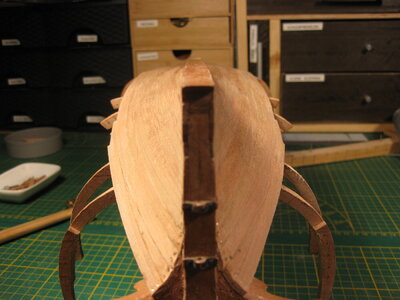
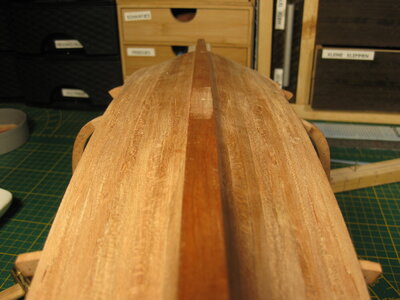
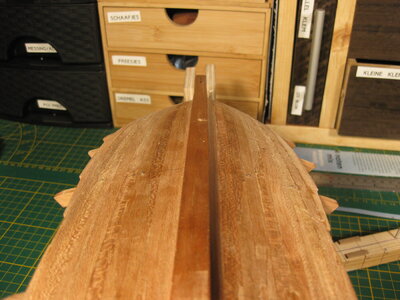
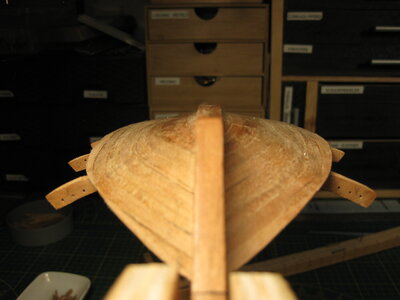
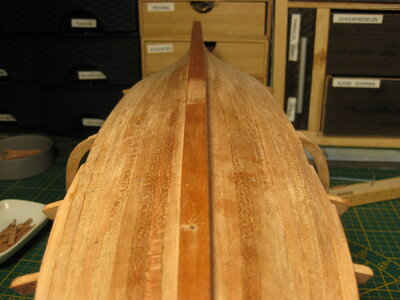
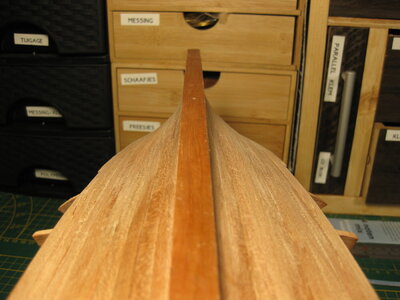
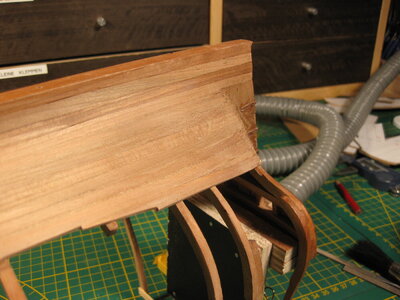
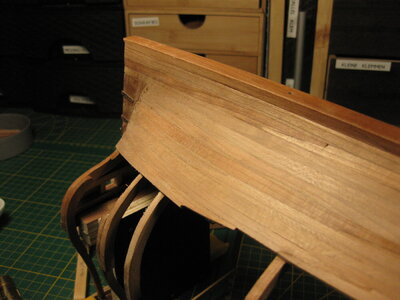
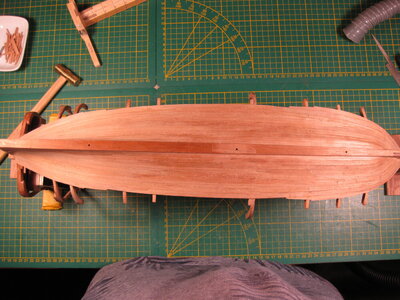
Thanks for the visit

I did today just a few small parts, but also a lot of rough sanding of the part that's done. I wanted to see if the hull is still in the right shape. And above all growing in the right shape. Don't look to the scratches and dents in the wood, this will be okay in the final sanding. there is here and there also some glue that I need to remove. The blackening of the brass needs a redo. That is for a later time. The shape is now first I want to check. See yourself. And please say it if something looks strange or not correct. I will check that part again. Maybe I see something not. (ps the steel nails are temporally)









Thanks for the visit
This is going to turn out fantastic!
Hi Stephan,
The edge bending tool seems to work great.
As far as I know on the actual ships I haven t found anythong that edge bending was actually done. More sawing the plank in the correct shape from a bended tree trunk.
Have you found a source that edge bending was done?
The edge bending tool seems to work great.
As far as I know on the actual ships I haven t found anythong that edge bending was actually done. More sawing the plank in the correct shape from a bended tree trunk.
Have you found a source that edge bending was done?
- Joined
- Aug 8, 2019
- Messages
- 4,139
- Points
- 688

Short answer about finding a source, no.Hi Stephan,
The edge bending tool seems to work great.
As far as I know on the actual ships I haven t found anythong that edge bending was actually done. More sawing the plank in the correct shape from a bended tree trunk.
Have you found a source that edge bending was done?
I use small strips and have to do this. And you know they sell only straight strips. To let it look like a plank of a bended trunk, edge bending is a solution.
Use a wide plank and shape it, does not make a stable plank. I see this in the Kolderstok Fluyd build where the planks are preshape/cut. They break when bending on the grain. Shipbuilders know this problem too.
That's why I do believe they did edge bending back in those days. When the right curved plank wasn't in stock.There is to much we don't know about how these ships where build.
- Joined
- Jan 9, 2020
- Messages
- 10,378
- Points
- 938

Now THAT is a true statement - especially on the Dutch ships where the shipwrights adopted a much freer approach!There is to much we don't know about how these ships where build.
- Joined
- Aug 8, 2019
- Messages
- 4,139
- Points
- 688

So true Heinrich, we just don't know. I think every shipyard in the Netherlands had a different approach. Even the books we have from Cornelis van Yk of Nicolaes Witse are questionable. Cornelis was a builder and did I think 7 years to write the book. He was a shipbuilder. Nicolaes only 2 years and he was no shipbuilder. It seems the pinas he wrote about was a Fluit actually. A writers mistake by the source he was used. And there is much more to study and read and still keep a lot of questions. Besides these questions and mistakes in the books, they still are a treasure chest of knowledge, I'm glad whe can read and study them.Now THAT is a true statement - especially on the Dutch ships where the shipwrights adopted a much freer approach!
I hope with building in this way my questions will be answered. And get some more knowing about these beautiful ships.
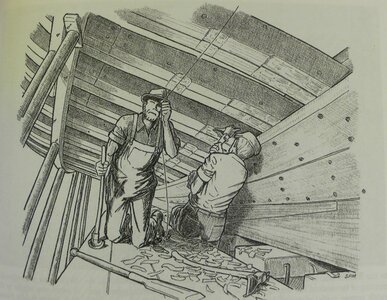
First a picture of some shipbuilders, doing almost the same like us. only bigger.
New planks to form for the bow, glueing the sides and then the last ones on the bow.
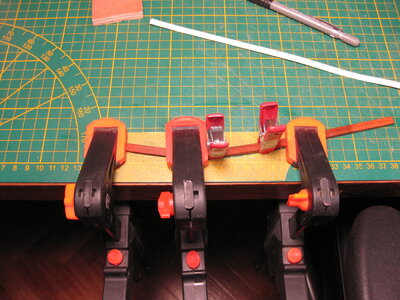
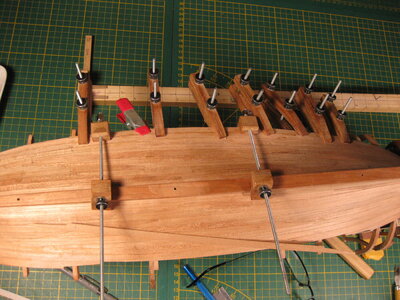
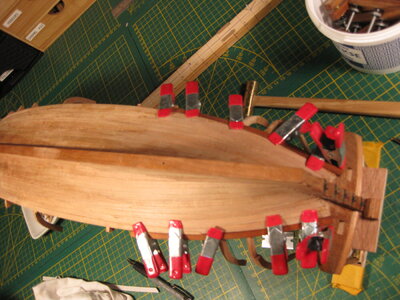
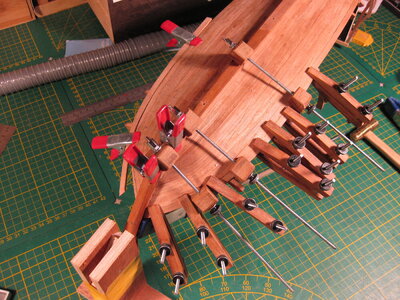
And then it was time to complete the next stage and fit the bilge on the main frames
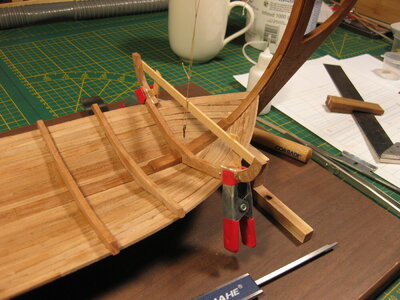
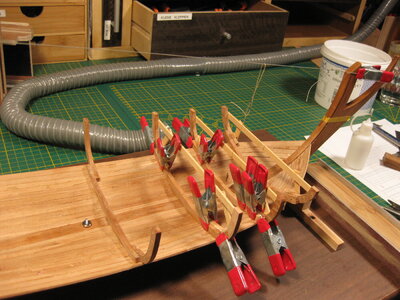
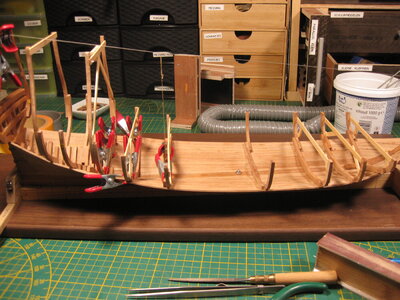
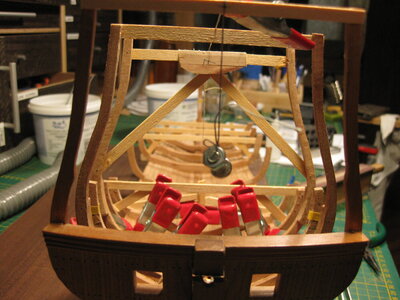
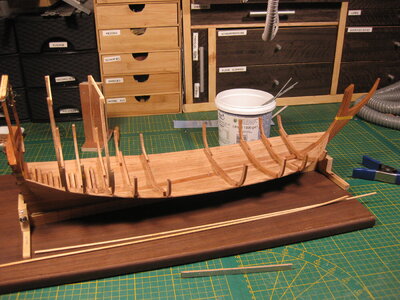
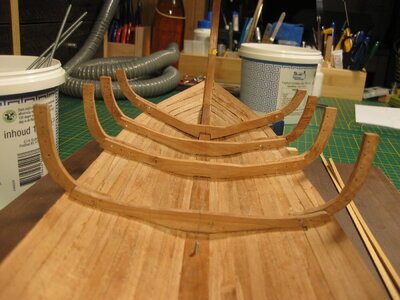
The tape on some frames and on the bow post are markings for the first wale.
And then we go further planking, I think 4 layers till the next stage.
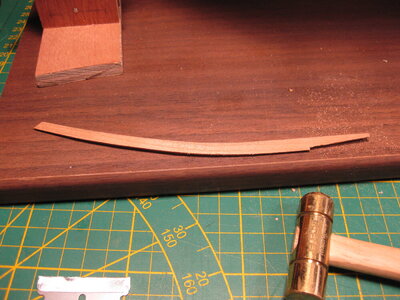
Before I glue it I have to adjust the frame, by sanding it till the plank fits well. A lot of adjustments on every plank.
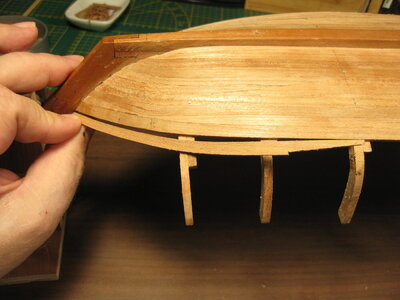
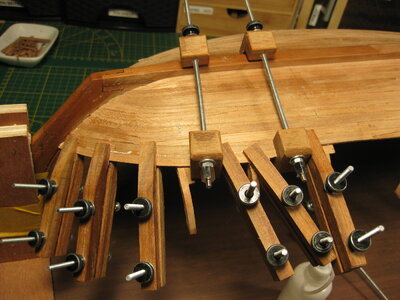
- Joined
- Sep 3, 2021
- Messages
- 4,250
- Points
- 688

Still very impressed with your "edge" or in-plane bending. I did some mild in-plane bending and it was rather tricky, especially when one has to do bending in two directions, like your planks on the Hohenzollernmodel. I can see why pre-cut planks may give a builder severe headaches; once the grain direction doesn't follow your bend plank curvature, you'll introduce stresses normal to the grain direction, with split planks as a result.
I am also wondering whether or not your experiences can be directly extrapolated to a full scale model, thus giving us more insight in the old shipwrights' way of building.
I am also wondering whether or not your experiences can be directly extrapolated to a full scale model, thus giving us more insight in the old shipwrights' way of building.
- Joined
- Jan 9, 2020
- Messages
- 10,378
- Points
- 938

Wow two excellent postings guys - first by Stephan on his exquisite and painstaking build and secondly, by @RDN1954 Johan for the very valid probing questions. This is quality participation and discussion at its best. @Steef66 Very interesting comment Stephan about Witsen's "pinas" versus a fluyt. I did not know this, but if this is so, then it would explain certain issues that I have had all along with Witsen's "pinas". One thing I have learnt is that the name or ship type ascribed to Dutch ships, often mean nothing. The ship of Willem Barentsz has been a called a "Jaght", "Boot", "Carvel" and "Vlieboot".
- Joined
- Aug 8, 2019
- Messages
- 4,139
- Points
- 688

Thanks Johan, I soak the planks a minimum of 24 hours under water (tip from Marcus @flying_dutchman2 ) and when I need an extra high in-plane bending I use a little boiler water before I bend. Works fine. Just take your time bending no rush, to avoid split. The I leave that to dry. Depends on the water conditions how long. But I let it dry till it is about 90% of the stage it was before soaking. Then I get the plank out of the clamps and start bending the other direction on the model. When the shape is right I place the plank on the ship after another hour of drying. When I need just a little bending I soak it inwater a shorter time. You need to experience this.Still very impressed with your "edge" or in-plane bending. I did some mild in-plane bending and it was rather tricky, especially when one has to do bending in two directions, like your planks on the Hohenzollernmodel. I can see why pre-cut planks may give a builder severe headaches; once the grain direction doesn't follow your bend plank curvature, you'll introduce stresses normal to the grain direction, with split planks as a result.
I am also wondering whether or not your experiences can be directly extrapolated to a full scale model, thus giving us more insight in the old shipwrights' way of building.
Sometimes it split a little bid, no problem, just a little dilluted White glue in the split and a little clamp to close the split. After sanding no problem to see.
If this build can be projecten to a real ship build? I don't know. Could be but in bigger scale there is a lot more that can be done. When you search on youtube there are a lot of video's of woodbuilders that build like this on small boats. So everything is possible because I seen a similar build like mine on a cano.
- Joined
- Aug 8, 2019
- Messages
- 4,139
- Points
- 688

Thanks Heinrich, very nice comment. In the post I react to Johan I discribe my method of bending. Hope it is clear.Wow two excellent postings guys - first by Stephan on his exquisite and painstaking build and secondly, by @RDN1954 Johan for the very valid probing questions. This is quality participation and discussion at its best. @Steef66 Very interesting comment Stephan about Witsen's "pinas" versus a fluyt. I did not know this, but if this is so, then it would explain certain issues that I have had all along with Witsen's "pinas". One thing I have learnt is that the name or ship type ascribed to Dutch ships, often mean nothing. The ship of Willem Barentsz has been a called a "Jaght", "Boot", "Carvel" and "Vlieboot".
About Witse I will search later the sources and evidence what I found about the subject.
- Joined
- Sep 3, 2021
- Messages
- 4,250
- Points
- 688

Hey Stephan,Thanks Johan, I soak the planks a minimum of 24 hours under water (tip from Marcus @flying_dutchman2 ) and when I need an extra high in-plane bending I use a little boiler water before I bend. Works fine. Just take your time bending no rush, to avoid split. The I leave that to dry. Depends on the water conditions how long. But I let it dry till it is about 90% of the stage it was before soaking. Then I get the plank out of the clamps and start bending the other direction on the model. When the shape is right I place the plank on the ship after another hour of drying. When I need just a little bending I soak it inwater a shorter time. You need to experience this.
Sometimes it split a little bid, no problem, just a little dilluted White glue in the split and a little clamp to close the split. After sanding no problem to see.
If this build can be projecten to a real ship build? I don't know. Could be but in bigger scale there is a lot more that can be done. When you search on youtube there are a lot of video's of woodbuilders that build like this on small boats. So everything is possible because I seen a similar build like mine on a cano.
Thanks for again an extensive reply to my post.
While reading your reply, I realized shipwright Willem Vos build a replica of the Batavia in Lelystad and I was hoping that build could shed some light on the shell-first build method on larger ships. Alas, I did find an interesting, albeit in Dutch, short documentary of the Batavia replica build, but, as far as I can discern, not a shell-first build: Batavia replica build.
Given the short video, not too many specific build details can be distinguished. Plank bending is shown, but that seems pretty straight forward, whereas I suspect some of the stem and stern planks would have been buggars to form, with a plank thickness of 100mm/4"...
Kind regards,
Johan
- Joined
- Oct 15, 2017
- Messages
- 986
- Points
- 403

Stephan, I've been out of circulation for a bit and just now getting caught up, on reading only.
I admire the projects both you and Maarten are working on. I understand the history and pride you both have in building those unique Dutch Fluyt ships. The work you take on in this project, as it, I suspect it was with the actual Dutch shipwrights a combination of science and art. I think you you have to be able to use both left and right sides of that brain of yours to go into analytical mode when needed and then switch gears and fire up your creative/artistic side, which this project most certainly requires.
As stated by others, super progress you've made.
Now, I can only imagine of someone not familiar with wooden ship modeling seeing the picture below that they would become dizzy in the head. I'm not sure, but think I counted 6 different fastener types, some of which you made yourself. Pretty impressive all around. All I have to say. Wonderful work.
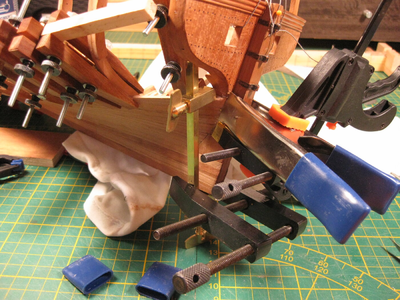
I admire the projects both you and Maarten are working on. I understand the history and pride you both have in building those unique Dutch Fluyt ships. The work you take on in this project, as it, I suspect it was with the actual Dutch shipwrights a combination of science and art. I think you you have to be able to use both left and right sides of that brain of yours to go into analytical mode when needed and then switch gears and fire up your creative/artistic side, which this project most certainly requires.
As stated by others, super progress you've made.
Now, I can only imagine of someone not familiar with wooden ship modeling seeing the picture below that they would become dizzy in the head. I'm not sure, but think I counted 6 different fastener types, some of which you made yourself. Pretty impressive all around. All I have to say. Wonderful work.

Stephan makes me dizzy too  ...
...
 ...
...- Joined
- Sep 3, 2021
- Messages
- 4,250
- Points
- 688

And the bad news? He's not he only one around here...Stephan makes me dizzy too...
Guys, guess you have to stop drinking.And the bad news? He's not he only one around here...
- Joined
- Nov 10, 2019
- Messages
- 316
- Points
- 373

Hello Stephan,
it is admirable with which devotion you create this model ship in original construction.Just like the shipbuilders did centuries ago 1:1. This modeling philosophy is right up my alley and I love it.
I always try to empathize with the situation of the trades of the time.
Just great!
it is admirable with which devotion you create this model ship in original construction.Just like the shipbuilders did centuries ago 1:1. This modeling philosophy is right up my alley and I love it.
I always try to empathize with the situation of the trades of the time.
Just great!
- Joined
- Aug 8, 2019
- Messages
- 4,139
- Points
- 688

Many, many, many thanks Ken.Stephan, I've been out of circulation for a bit and just now getting caught up, on reading only.
I admire the projects both you and Maarten are working on. I understand the history and pride you both have in building those unique Dutch Fluyt ships. The work you take on in this project, as it, I suspect it was with the actual Dutch shipwrights a combination of science and art. I think you you have to be able to use both left and right sides of that brain of yours to go into analytical mode when needed and then switch gears and fire up your creative/artistic side, which this project most certainly requires.
As stated by others, super progress you've made.
Now, I can only imagine of someone not familiar with wooden ship modeling seeing the picture below that they would become dizzy in the head. I'm not sure, but think I counted 6 different fastener types, some of which you made yourself. Pretty impressive all around. All I have to say. Wonderful work.
Your staples a time back make me dizzy to. But in the end I was surprised by your work.
Yes you got it right about the fasteners. 6 in total. It is very difficult to hold a plank in place at the right angle. Especially on the stern part. I use what I can find and use. Sometimes a piece of cord, or a hairpin and even ductape.
- Joined
- Aug 8, 2019
- Messages
- 4,139
- Points
- 688

Stephan makes me dizzy too...
And the bad news? He's not he only one around here...
I agree with Maarten, maybe the A.A. is a solution for you guys. But I have to warn you. It isn't anonymus at all, the first time I got there I recognize almost everybody there.Guys, guess you have to stop drinking.

